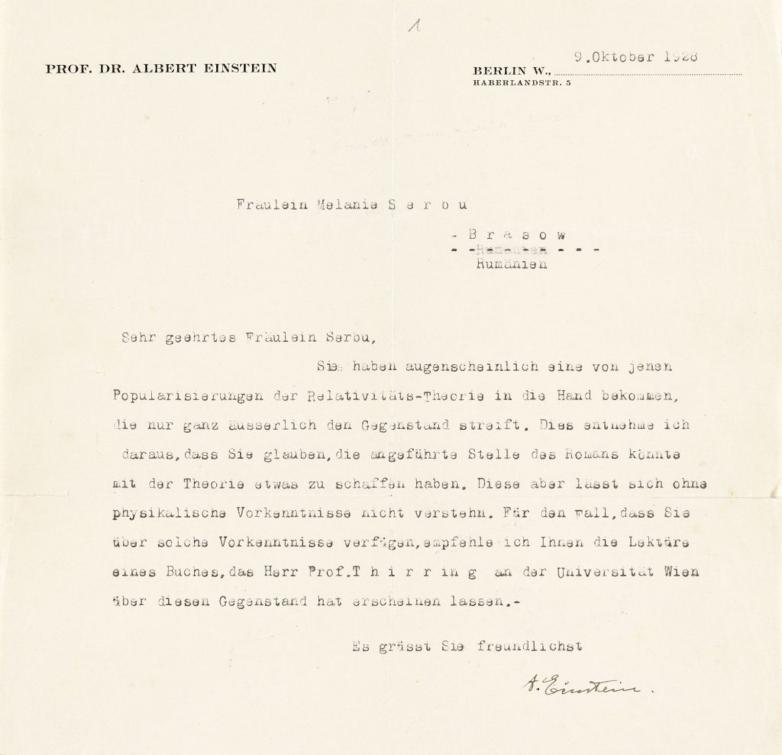Einstein-Serbu Correspondence to Auction

Albert Einstein, typed letter signed, to Melanie Serbu. 9 October 1928.
At the age of 19, young Romanian Melanie Serbu struck up a 20-year correspondence with Albert Einstein. The 20 original letters from Einstein to Serbu, together with more than 80 manuscript pages of Serbu’s later reflections on each letter, go under the hammer at Swann Galleries on October 26, one of the few occasions that a nearly-complete archive of correspondence by Einstein has come to auction.
Serbu had only vocational education and worked as a bank clerk in Brasov. But inspired by a magazine article on Einstein’s theory of relativity, she wrote to him for an explanation of his theory, mentioning that the topic had interested her since reading Poor Dionis, a novella by Romanian poet Mihai Eminescu (first published in 1872). The story focuses on a daydreaming scholar who travels through time and space by inhabiting the bodies of reincarnated selves, touching on notions of spacetime and relativity long before the widespread association of such ideas with Einstein’s theories.
Perhaps impressed by her boldness, Einstein replied by recommending a book introducing his theory: Die Idee der Relativitätstheorie (1921) by Hans Thirring:
“You have evidently got hold of one of those popularizations of the theory of relativity . . . . I took this from the fact that you believe that the quoted passage in the novel could have something to do with the theory. However, this cannot be understood without prior knowledge of physics. . . . I recommend reading a book on this subject that Prof. Thirring has published at the University of Vienna.” [Einstein to Serbu, 9 October 1928]
After repeatedly reading Thirring’s book over the course of months, Serbu again wrote to Einstein, hoping to demonstrate her understanding of his theory, gesturing toward recognition of the importance of the relationship between electromagnetic and gravitational effects:
“[T]he universe is flooded by two forces like a fog: gravitational and light waves. Basically the same electromagnetic forces, only under different names because they exert different effects. Shouldn’t the two stand in a certain relationship to each other?” [Serbu to Einstein, probably 26 November 1928]
Soon after, Einstein replied, so astonished that someone as young and untrained could have such insight into recent physics that he was moved to help her pursue study in theoretical physics. Before he committed, however, he wanted reassurance, because part of Einstein’s surprise lay in the fact that it was a woman who commanded this insight:
“[T]his study almost always takes its toll on women, because the great and constant mental effort is usually not good for them. . . . [T]ry to study a suitable work on mathematics privately alongside your job, in order to test yourself. If you let me know the status of your education in this regard, I will send you a suitable work.” [Einstein to Serbu, 9 January 1929]
In the same letter, Einstein mentions how Serbu’s insight happens to touch on his own work in theoretical physics:
“I was extraordinarily surprised that you immediately saw the point where the next progress must begin, namely the unity of the natural forces. I’ve been working on this problem for 13 years and I think I’ve found the solution right now.”
Einstein seemed satisfied by Serbu’s continued expressions of interest and, as promised, sent books on mathematics and physics, which Serbu studied diligently in the evenings after her work at the bank. On June 19, 1930, Einstein wrote to historian Nicolae Iorga, Romania’s Minister of Education, requesting that Serbu be permitted to attend university after an appropriate examination despite legislation preventing anyone without a baccalaureate degree from doing so. In a move that permanently improved the educational opportunities for women in Romania, Iorga arranged for the relevant law to be changed, allowing students without a degree to audit university courses.















